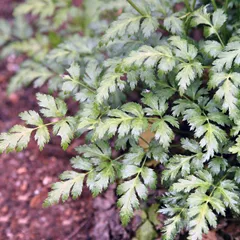Damp-Heat in the Stomach
The information provided here is not a replacement for a doctor. You shouldn't use it for the purpose of self-diagnosing or self-medicating but rather so you can have a more informed discussion with a professional TCM practitioner.
At a glance
Preliminary reading: What is a pattern? The concept of Dampness The concept of Heat The Stomach in Chinese Medicine
Key attributes
Chinese name: 胃湿热 Pinyin name: Wèi Shī Rè
Pattern nature: Full
Causes
Precursor patterns: Stomach Heat or Fire Spleen Qi Deficiency
Common causes: 1. Diet, 2. Emotional stress
Diagnosis
Common symptoms: Nausea Facial pain Blocked nose Epigastric pain Feeling of heat and six other symptoms
Pulse type(s): Rapid (Shu), Slippery (Hua)
Tongue description: Red with sticky yellow coating
Treatment
Treatment principle: Resolve Dampness, clear Heat, restore the descending of Stomach Qi.
Common formulas: Lian Po Yin Ge Hua Jie Cheng San
Pathology
In this pattern Dampness obstructs the Stomach, which prevents the descending of Stomach Qi and causes nausea and a feeling of fullness of the epigastrium.
The Stomach Channel connects to the face so the Dampness also leads to the symptoms of facial pain, blocked nose and thick nasal discharge. Viewed from a Western medicine standpoint, this pattern is a common cause of chronic sinusitis.
The feeling of heaviness is also caused by Dampness which obstructs the muscles.
The Heat dimension of the pattern causes thirst but the obstruction of the Middle Burner (where the Stomach is located) by Dampness makes the patient reluctant to drink. This is a somewhat counter-intuitive symptom but one commonly reported by patients suffering from this pattern.
Causes
Precursor patterns: Damp-Heat in the Stomach can derive from Stomach Heat or Fire Spleen Qi Deficiency
Diet: Greasy fried foods are especially likely to cause this pattern as they tend to create Dampness and frying makes food hotter in nature.
Emotional stress: Emotional strain due to anger, frustration and resentment may lead to Stomach Qi Stagnation which, over time, produces Heat. Since Qi is Hot in nature, making it stagnant leads to a concentration of Heat.
Diagnosing Damp-Heat in the Stomach
Diagnosing a pattern in Chinese Medicine is no easy feat and should be left to professional practitioners. In particular one has to know how to differentiate between different types of pulses and tongue coatings, shapes and colors as well as learn to read from a long list of seemingly unrelated symptoms.
Pulse type(s): Rapid (Shu) or slippery (Hua)
Tongue description: Red with sticky yellow coating
Main symptoms: Nausea Facial pain Blocked nose Epigastric pain Feeling of heat Epigastrium fullness Feeling of heaviness Thick nasal discharge Dull-yellow complexion Sticky taste in the mouth Thirst without a desire to drink
Diagnosis commentary: Epigastric fullness, nausea and a sticky yellow tongue coating are enough in and of themselves to diagnose Damp-Heat in the Stomach. Together with the feeling of heaviness they constitute this pattern's key symptoms.
Treating Damp-Heat in the Stomach
Treatment principle
Resolve Dampness, clear Heat, restore the descending of Stomach Qi.
Herbal formulas used to treat Damp-Heat in the Stomach



The top herbs in Lian Po Yin are Goldthread Rhizomes (Huang Lian), Houpu Magnolia Bark (Hou Pu) and Cape Jasmine Fruits (Zhi Zi)
Lian Po Yin
Source date: 1862 AD
Number of ingredients: 7 herbs
Key actions: Clears Heat. Transforms Dampness. Regulates Qi. Harmonizes the Middle Burner.
Formula summary
Lian Po Yin is a 7-ingredient Chinese Medicine formula. Invented in 1862 AD, it belongs to the category of formulas that clear Heat and expel dampness.
Besides Damp-Heat in the Stomach, Lian Po Yin is also used to treat Damp-Heat invading the Spleen or Damp-Heat.



The top herbs in Ge Hua Jie Cheng San are Kudzu Flowers (Ge Hua), Cardamon Fruits (Bai Dou Kou) and Amomum Fruits (Sha Ren)
Ge Hua Jie Cheng San
Source date: 13th century
Number of ingredients: 13 herbs
Key actions: Separates and reduces alcohol-dampness. Warms the Middle. Strengthens the Spleen .
Formula summary
Ge Hua Jie Cheng San is a 13-ingredient Chinese Medicine formula. Invented in 13th century, it belongs to the category of formulas that reduce food Stagnation with tonification.
Besides Damp-Heat in the Stomach, Ge Hua Jie Cheng San is also used to treat Damp-Heat in Stomach and Spleen.
Diet recommendations
Favor a diet free of dairy and fried and/or greasy foods. In general since there is Heat, ensure your diet has a higher concentration of cold-natured ingredients.
Consequence patterns
Damp-Heat in the Stomach may give rise to Phlegm or, more specifically, Phlegm-Heat.
